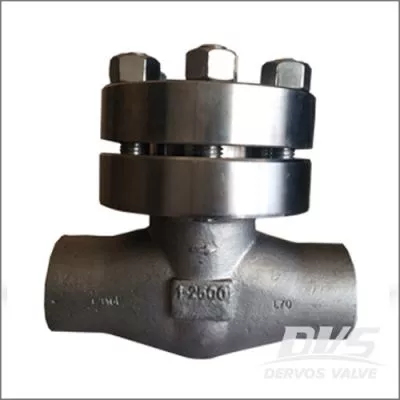Classification and structure characteristics of forged check valves
According to their connecting formats, the above several types of forged check valves can be divided into four types: threaded connection, flanged connection, welded connection and butt clamped connection.
A forged check valve is a valve whose opening and closing member is automatically opened or closed by the flow of the medium and the force to prevent the back flow of the medium. Forged check valves are automatic valves, mainly used on pipes with one-way flow of media, allowing only the media to flow in one direction to prevent the emergence of accidents.
Swing-type check valve: The valve flap of the swing-type check valve has a disk shape and rotates around the rotation shaft of the valve seat passage. Since the valve passage is streamlined, the flow resistance is smaller than that of the lift check valve. It is suitable for large diameter pipeline applications where the flow rate is low and flow are not changed frequently, but it is not suitable for pulsating flow, and its sealing performance is not as good as that of a lifting type check valve. The swing-type check valve is divided into three types: single flap, double flaps and multi-flap. These three forms are mainly divided according to the valve diameter. The purpose is to prevent the hydraulic shock from being weakened when the medium stops flowing or reverses.
Lift check valve: when the valve flap is sliding along the vertical centerline of the valve body, the lift check valve can only be installed on the horizontal pipe, and the valve flap can be a ball when used on the high pressure small diameter check valve. The shape of the lift check valve is the same as that of the shut-off valve (function same as the shut-off valve). So, the lift check valve has a relatively large fluid resistance coefficient. Its structure is similar to the shut-off valve, the valve body and the valve flap are the same as the shut-off valve. The upper part of the valve flap and the lower part of the valve cover are machined with guide sleeves, and the valve flap guide sleeve can be easily lifted and lowered in the valve guide sleeve. When the medium is downstream, the valve flap is opened by the medium thrust. When the medium stops flowing, the valve flap is landing itself on the valve seat. The drooping falls on the valve seat are to prevent the medium from flowing back. The direction of the inlet and outlet passages of the straight-type lifting check valve is perpendicular to the direction of the valve seat passage; the vertical lift check valve has the same direction of the medium inlet and outlet passages as the valve seat passage, and its flow resistance is smaller than that of the straight-through type.
Disc type check valve: A check valve whose valve flap rotates around the pin in the valve seat. The disc type check valve has a simple structure and can only be installed on a horizontal pipe, and the sealing performance is relatively poor.
Pipeline check valve: A forged check valve whose valve flap slides along the centerline of the valve body. Pipeline forged check valve is a new type of check valve. It is small in size, light in weight and good in processing technic. It is one of the development directions of check valves. However, the fluid resistance coefficient is slightly larger than that of the forged swing check valve.
Compact check valve: This forged valve is used as a boiler feed water and steam shut-off valve. It has a comprehensive function of a forged lift check valve and a forged shut-off valve or a forged angle valve.
